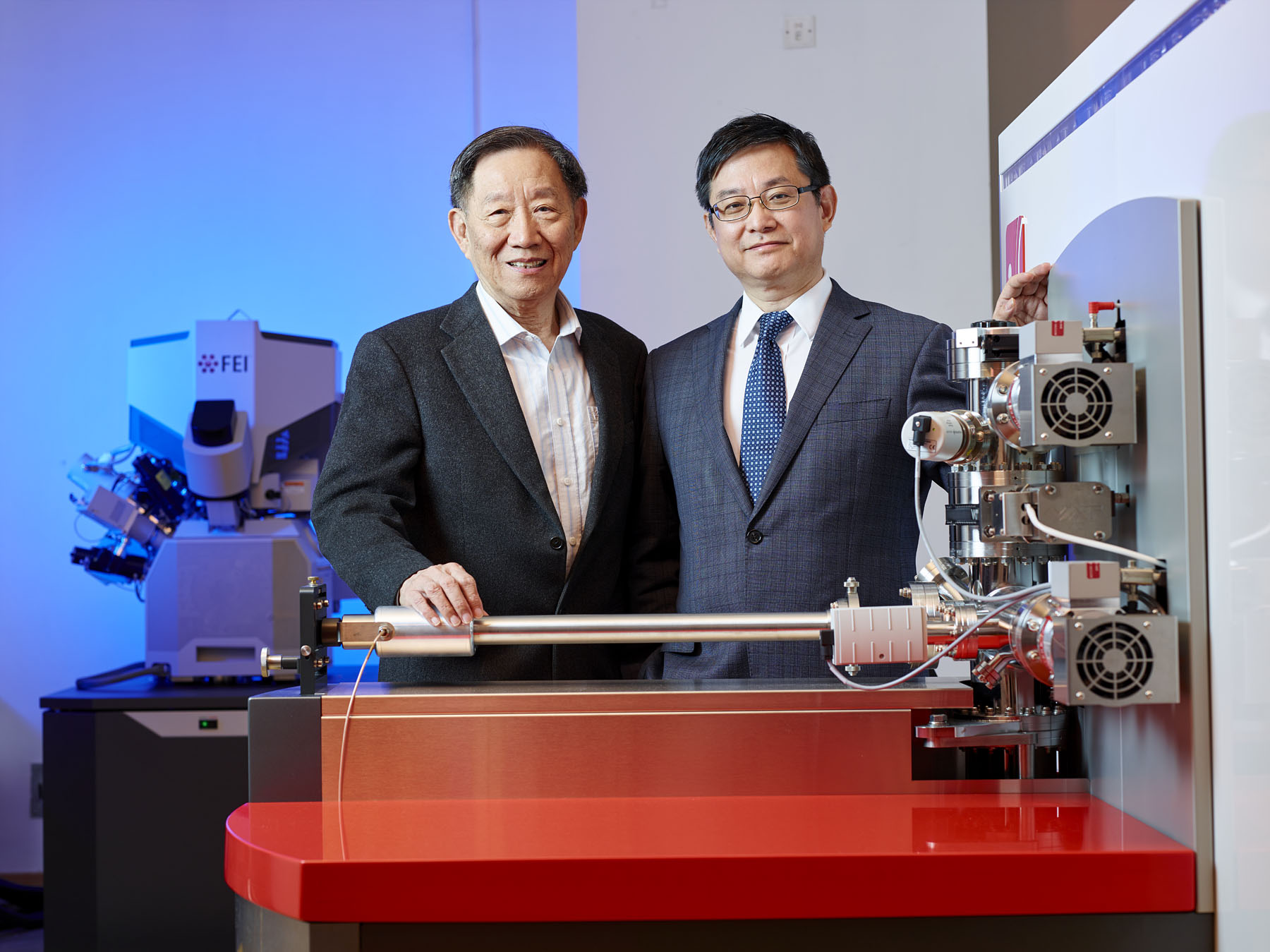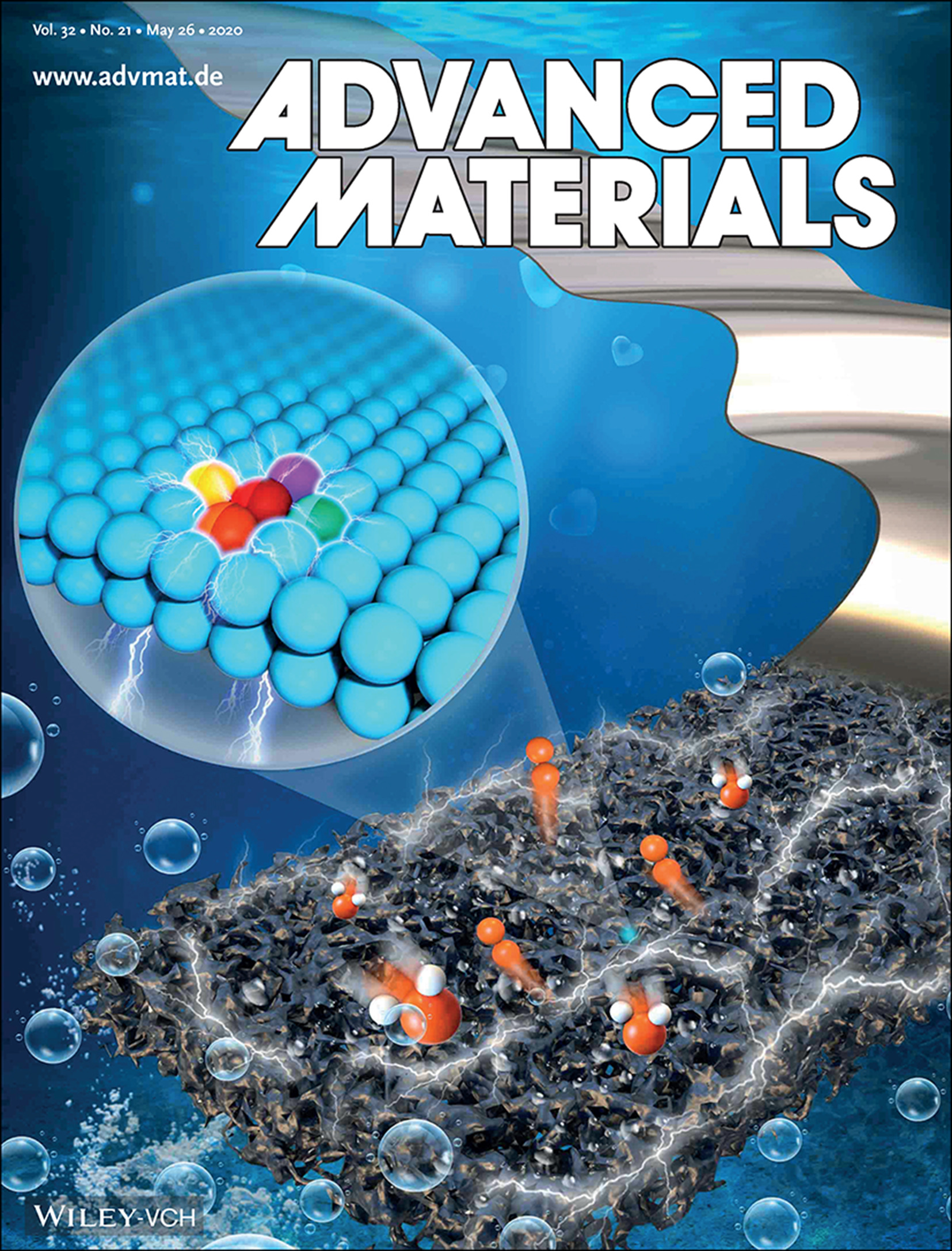A low-cost and high-performance multinary intermetallic compound as an active electrocatalyst for hydrogen production
Considering hydrogen as a clean energy for future, scientists have been striving to develop novel processes to produce hydrogen efficiently and cost-effectively. A team comprised of scientists who specialized in structure materials at City University of Hong Kong (CityU) has developed a high-performance electrocatalyst based on an innovative concept originally for developing alloys. The new electrocatalyst can be produced at large scale and low cost, providing a new paradigm in a wide application of hydrogen production by electrochemical reaction in future.
The research output was co-led by Professor Lu Jian, CityU’s Vice President (Research and Technology) and Chair Professor of Mechanical Engineering, and Professor Liu Chain-tsuan, University Distinguished Professor of the College of Engineering. The findings were published on the international top academic journal Advanced Materials with the title of “A Novel Multinary Intermetallic as an Active Electrocatalyst for Hydrogen Evolution”.
When consuming in a fuel cell, hydrogen only produces water without any generation of carbon dioxide. Therefore, it is commonly regarded as an ideal clean source to tackle the problems of greenhouse gases and energy shortage. Compared to other methods of hydrogen production, electrochemical water splitting is a relatively environmentally friendly process with promising and great potential in industrial application. However, the most current developed electrocatalysts are noble-metal based, such as platinum and palladium. Their high costs and scarcity greatly hinder the development and applications of this hydrogen production method.
Earlier before, Professor Liu has developed an innovative alloy design strategy for manufacturing high-entropy intermetallic compounds. This strategy overcomes the trade-off dilemma between strength and ductility in traditional metallic materials by introducing high density of nanoparticles of multi-component intermetallic compounds at the nano-scale. The findings were published in the prestigious journal Science. Since the high-entropy intermetallic compounds possess well-ordered atomic structures and chemical synergistic functions (thanks to its multi-components) – both of which promote the electrocatalytic performance, the new alloy design strategy also provides insight for developing novel electrocatalysts.
Professor Liu’s team joined hands with Prof Lu’s one who are experts in noble metal research and managed a new high-entropy intermetallic (HEI) electrocatalyst by adopting the aforementioned alloy design strategy. The new electrocatalyst is mainly comprised of five metal elements: iron, cobalt, nickel, aluminium and titanium. It also has a well-ordered atomic structure. Through a simple and one-step chemical method, the team produced a dendrite-like porous structure which greatly increase the surface area for electrochemical activities and hence significantly enhancing the electrochemical performance.

The high-entropy alloys (HEAs) usually refers to new alloys made of four or more metal elements, with good mechanical, physical, chemical and other properties. Since it contains varieties of elements, the synergistic functions among the different chemical elements provide huge possibilities to optimize the catalytic performance. However, the conventional HEAs have disordered atomic distribution in their solid solution, so it is difficult to effectively alter the electronic structure and active sites to finally promote the electrochemical reaction.
On the other hand, intermetallic compound is a type of metallic alloy formed by metallic elements, or by metallic elements with one or more non-metallic elements, whose crystalline structure differs from those of the other constituents. Since the multinary metal atoms are uniformly distributed in its well-ordered intermetallic structure, it enables a specific site-isolation effect. And its electronic structure is highly tunable. So it is considered as a promising catalyst. However, most of the current research on intermetallic electrocatalysts focus on binary alloys which don’t have the synergistic functions among the multinary metal elements.
Therefore this research outcome is actually the result of combining the advantages of high-entropy alloys (synergistic effects among multinary metal elements) and intermetallic compounds (intrinsic structural site-isolation effect and well-tuned electronic structure).
By using the atomic-resolution scanning transmission electron microscopy (Cs-corrected) and 3D-atomic probe tomography in experiments, the team characterized the atomic structure of HEI electrocatalyst. With further theoretical calculations, they proved that the synergistic effects and the well-ordered atomic structure effectively optimize the electronic structure, and hence promote the electrochemical water splitting process.
Because of its unique constituents and structure, this HEI catalyst performs excellent hydrogen evolution reaction in alkaline electrolyte solution.

“Our unique strategy to produce HEI uncovers a new paradigm to develop novel electrocatalyst with superior reaction activities for splitting water and producing hydrogen,” said Professor Liu.
“The method that we used to prepare the HEI has already been widely employed in industrial production. Since we use the cheaper metals as raw materials, we believe this novel electrocatalyst will have promising application potential in industrial production of hydrogen,” Professor Lu added.
The co-first authors are Dr Jia Zhe (currently working in the University of New South Walesin Sydney, Australia), Dr Yang Tao and Dr Sun Ligang (currently working in Harbin Institute of Technology), who are all from CityU. Other co-authors from CityU include: Professor Jacob Huang Chih-ching, Chair Professor of Materials Science, Professor Kai Jijung, Chair Professor of Nuclear Engineering, post-doc fellow Dr Zhao Yilu, Dr Luan Junhua, Senior Research Associate at the Inter-University 3D Atom Probe Tomography Unit, as well as PhD students Li Wanpeng from Department of Materials Science and Engineering and Lyu Fucong from Department of Mechanical Engineering.


Related stories:
Extremely strong and yet incredibly ductile multicomponent alloys developed